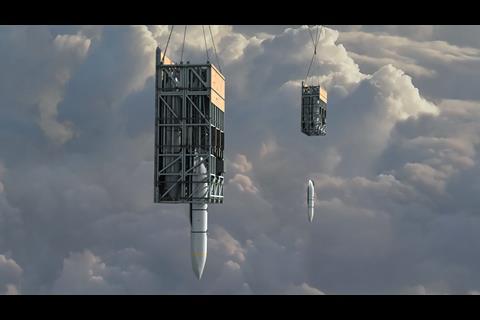Lockheed Martin plans to demonstrate the ability to launch a Joint Air-to-Surface Standoff Missile-Extended Range (JASSM-ER) from the back of an MC-130J transport by the end of the year, as it works to develop a palletised launch system called ‘Rapid Dragon’.
The upcoming demonstration is part of the Air Force Research Laboratory’s Rapid Dragon experiment, an effort to develop a system to launch long-range cruise missiles from the rear ramp of transport aircraft. The system will package a group of cruise missiles in a rack that sits on a standard pallet, which rolls down and off a cargo ramp. The system deploys a parachute to slow its descent, before ejecting cruise missiles which then fly to their targets.
Lockheed has been testing pieces of the Rapid Dragon system over the past year. Earlier this month, it demonstrated launching the system from a Boeing C-17 Globemaster III transport as well as from a Lockheed EC-130 Compass Call airborne jamming aircraft during flights over White Sands Missile Range in New Mexico, the company said on 21 September.
“Once stabilised by parachutes, the pallets released surrogate missiles in quick succession, each aerodynamically identical to a JASSM-ER,” Lockheed says.
During the recent drops, a ground crew also transmitted new targeting information to the Rapid Dragon system via an unnamed beyond line-of-sight communication system.
“The ability to retarget missiles while the aircraft is airborne provides combatant commanders the flexibility to respond to changes in a dynamic operational environment,” says Lockheed.
In the coming months the company plans to test launch an additional JASSM-ER surrogates from an MC-130J special operation transport.
“This test missile will have deployable wings and tail fins,” says the company. “The goal is to show that a JASSM-ER can stabilise itself after a vertical pallet drop.”
TEMPORARY ‘ARSENAL PLANE’
Before the end of the year the launching of an actual JASSM-ER will be attempted from an MC-130J. In that flight, Lockheed aims to have the cruise missile deploy its wings, stabilise and then begin powered flight. A similar test will be attempted from a C-17 in the spring of 2022.
“These tests will inform potential design refinement and accelerate the maturation of these systems for further capability experimentation and rapid fielding,” says Lockheed.
The US Air Force (USAF) wants new ways to launch its cruise missiles en masse – in addition to its bomber force – so that it can overwhelm and penetrate the air defences of advanced adversaries such as China or Russia. In 2019, the US Department of Defense increased its potential long-term production quantities of JASSM from a possible maximum of 4,900 to a possible maximum of 10,000.
However, the idea of using the USAF’s transports to launch cruise missiles is not settled strategy. Some believe dedicated bombers are a better use for defence funding, perhaps including developing a new “Arsenal Plane”, designed specifically for launching large numbers of munitions. Others do not want the service’s cargo fleet diverted from its core mission of transporting people and materiel.
The debate aside, the USAF is already eyeing additional uses from its Rapid Dragon system after proving it useful for launching cruise missiles.
“The deployment module can be adapted to other munitions, and is compatible with standard airdrop systems,” says Lockheed. “The air force is planning a follow-on programme for 2022 that will look at expanding palletised munitions to include multiple weapons and effects.”


































